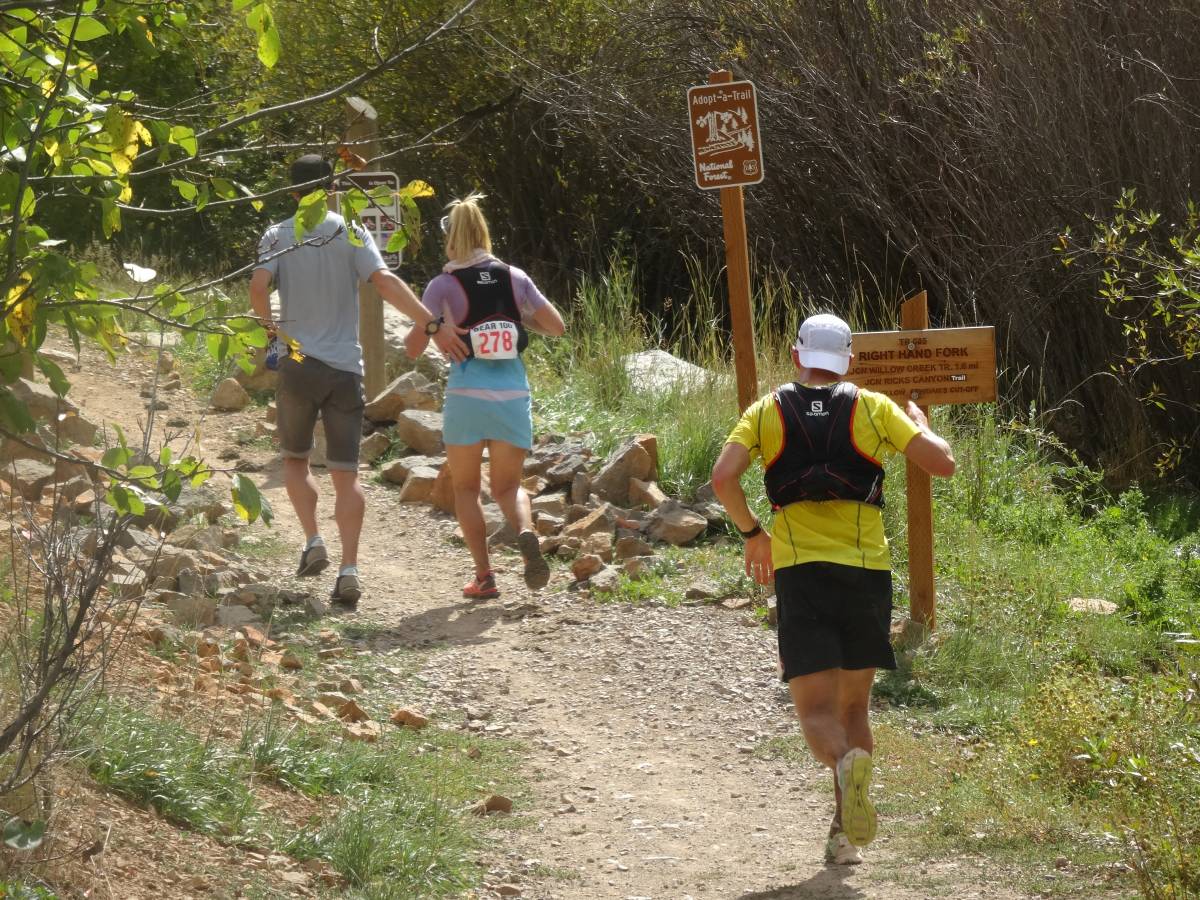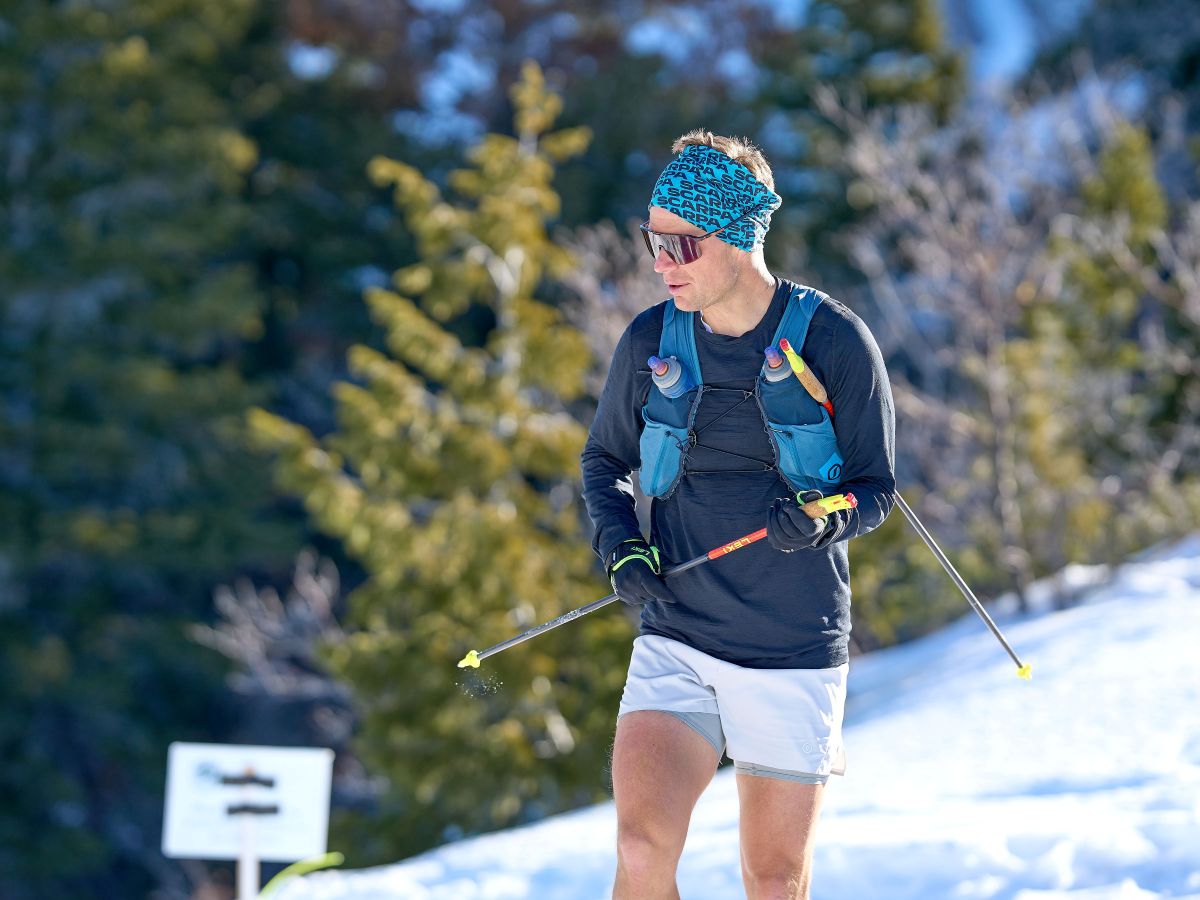In this monthly article series, ultrarunner, race director, and coach Gabe Joyes answers reader questions about anything and everything running. Learn more about this ask-the-athlete column, and be sure to fill out the form below to submit your questions for a future article!
This month, Gabe answers questions about the benefits of hill repeats, how to recognize under-fueling, gaining confidence on downhills, and more.
Gabe’s Tip of the Month
Do your homework at home — or at least on the trails! About a month ago, I was on the shuttle bus to the starting line of the Canyons 100 Mile, and with deep fascination, I watched two runners try to figure out how to correctly wear the Leki “gloves” that are used to bind the running poles to one’s hand. These two gentlemen tried the gloves backward, inside out, upside down, and basically every conceivable possibility, and I was grateful they provided me with a solid 15 minutes of entertainment during the hour-long journey. Don’t worry, I would have helped them if they hadn’t figured it out by the end of the drive.
Over the years, I have noticed that I almost never see anyone out on a training run using poles, but I see just about everyone use them during 100-mile races. Running poles are a very helpful tool that perhaps surprisingly requires a great deal of skill and technique to use effectively, and anything that involves skill requires some time for mastery. So do your homework well before the race, or at least before the shuttle ride to the start!
Hill Workouts: What is Beneficial?
There’s a road by my house that goes up a mountain. It’s a little over a mile long straight uphill with an average gradient of 11%. I like to do repeats on it — I can only manage two or three at a shuffling pace — because it’s a tough challenge and sends my heart rate through the roof. But I wonder, is this a valuable workout? What physiological benefits does it provide? Would I be better off running shorter, faster repeats? – Chris
An 11% grade for one mile is about 580 feet per mile — that’s a properly steep climb! A beauty of a hill like that not only provides the training ground ideal for a few different types of workouts, but also provides an excellent character development opportunity! Try these two workouts:
- The first one is pretty much as you have been doing. Uphill intervals of roughly 8 to 12 minutes fall squarely into “tempo run effort,” or rate of perceived exertion (RPE) 7 to 8, or just a little bit above threshold. If you can do 2 to 3 full mile repeats, I’d guess each lap would take about that 8 to 12 minutes, which is perfect. Take that recovery run back downhill to the bottom super easy to let that sky-high heart rate recover.
- The other workout you could do is some rather uncomfortably high intensity VO2 max intervals — these are RPE 9 to 10 and might leave you seeing stars by the end. Run uphill as hard as you can for 2 to 3 minutes, and then recovery run downhill as easily as you’d like for an equal amount of time. Repeat this 4 to 6 times for a sky-high heart rate and mega mitochondria boost for the big muscles in your legs.
Both of these workouts are extremely difficult, and I recommend an extra dose of carbohydrates both before and after to support the training load — and all of the new character you just developed.

Uphill interval work showing up on race day at Lavaredo in the Italian Dolomites. Photo courtesy of Gabe Joyes.
Hiking Technique
Hi, why do I get bad back pain while walking or hiking but not while running and what can I do to help? This becomes more of a problem for me for at ultramarathon distance when I hike more. – Jim
Running and hiking do utilize slightly different muscles and are two different skill sets — just like anything, they both take practice. I’ll never forget learning this lesson at The Rut 50k in 2013 as I ran uphill right behind Anna Frost, yet I watched her pull away from me while she was hiking faster than I was running. (Spoiler alert: she comprehensively beat me that year at the Telluride Mountain Run, The Rut, and the Bear 100 Mile.)
Often when we hike uphill there is a resistance to using the lower back muscles — you’ll see some people put their hands on hips in an effort to support the lower back, or you’ll also see others hunch over with a curve in the spine. Keep the core straight and strong from the glutes, through the hips, and into the lower back! Doing some core/strength training exercises like planks, glute bridges, bird dog, or others makes a big difference in strengthening that section of the core as well.

Your author foolishly attempting to keep up with Anna Frost at the Bear 100 Mile in 2013. Photo courtesy of Gabe Joyes.
Under-Fueling
Could it be possible that I am under-fueling? I don’t think so because my weight is steady, I don’t feel that hungry most of the time, and I could even stand to lose a few pounds. But I feel like I have no stamina while running uphill or during speed sessions, and it takes me a couple days to recover from a workout. I also frequently crash out and have to take a nap after I run. What’s up with this? – Anonymous
Energy literally comes from food, so anytime you feel like you are lacking stamina, speed, or power to complete a physical activity you indeed have the fitness for, then there is a solid chance you just do not have enough fuel in the tank.
Body weight is a notoriously unreliable marker of how well fueled you are because under-fueling can put your body in a state of low energy availability (LEA). Registered Dietician for Uphill Athlete Alyssa Leib explains that, “With low energy availability the body is forced to make tradeoffs: slowing metabolism, impairing recovery, and prioritizing basic survival over performance. Hormonal shifts can blunt hunger signals, so you might not feel hungry even when your body is starving for food. LEA may also slow metabolism, preventing weight loss and, in some cases, contributing to weight gain.”
You can even do a really simple experiment with yourself by doing the same challenging workout or hill climb once with your normal diet, and a second time with plenty of extra carbohydrates in the 36 hours before the run. I’m not usually a gambler, but I’d bet you a family size bag of Peanut M&Ms you’ll feel dramatically better the second time around!

A fully energized Alyssa Malley working her way up the steep climbs of the Kealia Quad Crusher. Photo: Kalani Pascual
Downhill Running
What tricks and tips do you have for improving downhill running? I feel especially slow on rocky downhills and I often lose places here in races. – Rosa
Downhill running is extra challenging because as much as it is a physical struggle, for many of us it is just as much a mental hurdle as well. I’ve found that single-leg plyometric drills done at high speed are excellent for preparing your muscles and soft tissue for the demands of racing downhill. I also recommend thinking about running smooth — not fast — as the more loose and flowy we are while descending the less impact there is on our bodies as well. The other reality is that short strides downhill do keep our center of gravity underneath us (and therefore much safer), but longer and more powerful strides are definitely faster (but at a higher risk of injury.) See if you can find the balance and build up the confidence over time to stride things out a bit more. How do we build confidence for downhill running? Train your mind!
Studies (1)(2) have shown that mental training and visualization practice can significantly improve physical performance. Visualizing yourself successfully flying down steep and rocky trails can improve how you actually run while out on those wild descents.
Sport and Performance Psychology Professional, Alex Bridgewater, explains that “Training your mind is a lot like training your body. It takes time and effort. The challenge is that we don’t get direct feedback that things are changing. Our brain is not a muscle, so it doesn’t grow larger. However, with time and acute attention to mental aspects of performance like, visualization, mindfulness, and acceptance practices, and working to relate better to how we think and feel, before, during, and after our performances, we give ourselves the opportunity to perform in the ways that make us proud of ourselves. Mental reps are a thing, make sure you do them.”
Your author fully focused on the descent at the Brecon Beacon mountains of Wales after months of mental visualization training. Photo: @nolimits.photos
Notes/References
- Dello Iacono A, Ashcroft K, Zubac D. Ain’t Just Imagination! Effects of Motor Imagery Training on Strength and Power Performance of Athletes during Detraining. Med Sci Sports Exerc. 2021 Nov 1;53(11):2324-2332. doi: 10.1249/MSS.0000000000002706. PMID: 34033625.
- Holmes, P.S., & Collins, D.J. (2001). The PETTLEP approach to motor imagery: A functional equivalence model for sport psychologists. Journal of Applied Sport Psychology, 13(1), 20-83.
Submit Your Questions
Send us your questions! Use the form below, or send us a message on Instagram, and we’ll consider your questions for future articles.
Call for Comments
- What do you think of Gabe’s answers to this month’s questions?
- What other questions do you have for Gabe? Send them our way!

